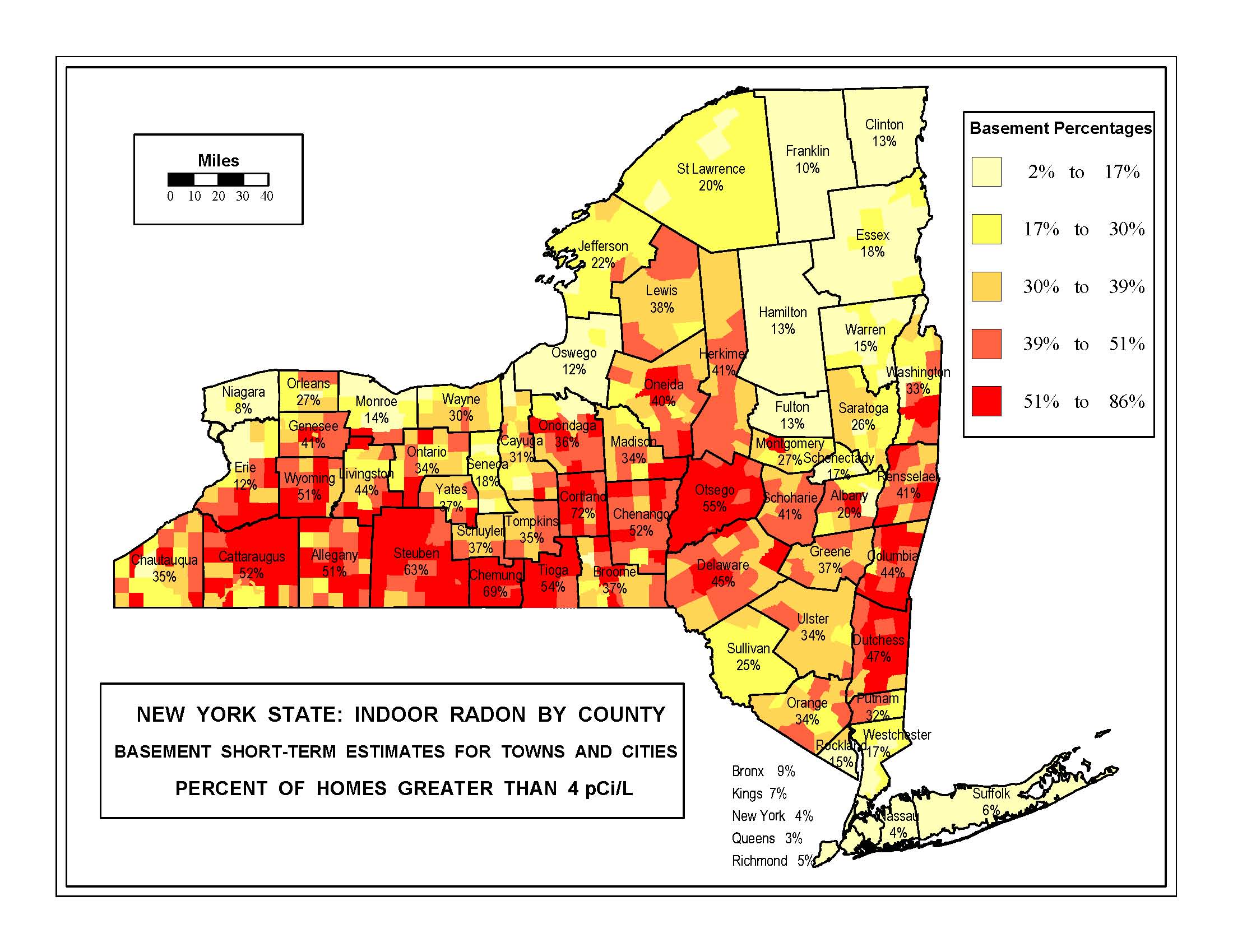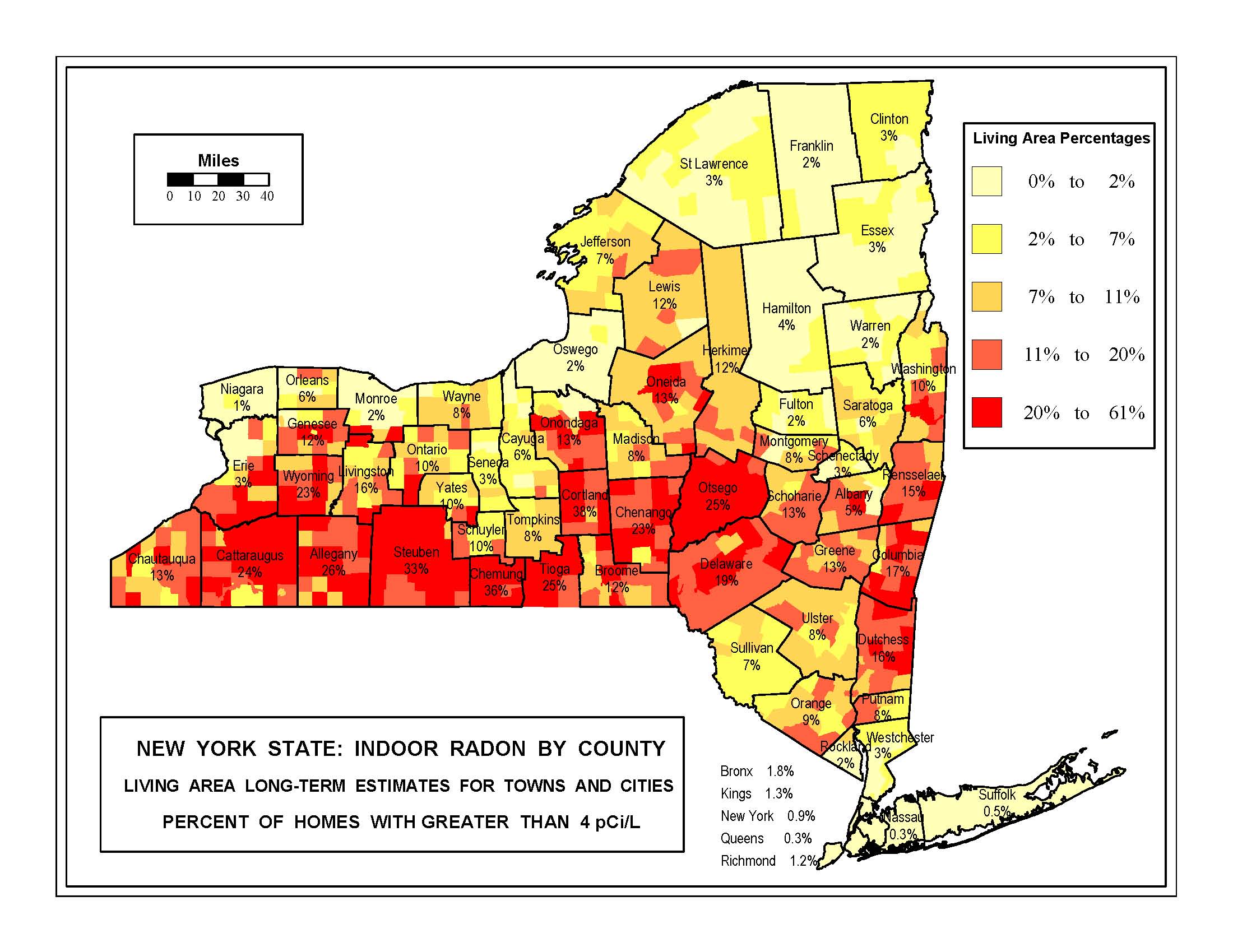Radon
New York State Department of Health Radon Monitoring Program
The Radon Section of the New York State Department of Health conducts a variety of outreach activities to educate the public on radon risks, as well as remediation. These activities include the detector distribution program, assistance to schools and county health departments, participation in exhibits, educational meetings of building and real-estate professionals, and research studies. A Radon Hotline (518-402-7556) is maintained to provide information to the public on testing procedures, mitigation techniques, and reporting requirements.
The New York State Department of Health website[1] provides useful information such as FAQs in addition to information concerning:
- Testing:
- Certified Radon Testers[2]
- Finding certified testing laboratories[3]
- Mitigation:
- Real Estate[6]
- Radon Resistant New Construction[7]
Radon Awareness
- National Radon Action Month[8]
- Reporting Requirements[9]
- NYS Real Estate Disclosure Law[10], next click RPP, then Article 14 and finally 462
- Radon Information for Physicians[11]
Information for Teachers
Studies
- Health Risks from Exposure to Low Levels of Ionizing Radiation: Board on Radiation Effects Research (BEIR) VII Phase 2 (2006)[13]
- University of Iowa Radon Lung Cancer Study[14]
For Professionals
- American Association of Radon Scientists and Technologists - National Radon Proficiency Program (AARST - NRPP)[15]
- AARST Foundation[16]
- AARST Consortium on Radon Standards[17]
- American Society for Testing and Materials (ASTM) International[18]
- Canadian Association of Radon Scientists and Technologists (CARST)[19]
- Conference of Radiation Control Program Directors (CRCPD)[20]
- Health Physics Society (HPS)[21]
Training Centers
- Eastern Regional Radon Training Center[22]
- Midwest Universities Radon Consortium - Kansas State University[23]
For the Lay Person
- American Cancer Society[24]
- American Lung Association[25]
- Central New York Coalition for Healthy Indoor Air[26]
- National Cancer Institute (NCI)[27]
- US Department of Housing and Urban Development[28]
Government Reference Sites
- Agency for Toxic Substances and Disease Registry, CDC[29] - Toxic Substances Portal
- Agency for Toxic Substances and Disease Registry, CDC[30] - Environmental Health and Medicine Education
- Environmental Protection Agency[31] with information for Individuals and Families; Home Buyers and Sellers; and Builders and Contractors
- US Geological Survey[32]
- World Health Organization[33]
New York State Levels of Radon
Between 1986 and 2007, over 45,000 basement screening measurements and over 11,000 long-term living area measurements were collected through the New York State Department of Health's ongoing detector distribution program. Because this type of data does not significantly change over time, it is still valuable today.
The maps below are to be used as a guide in matters regarding measuring homes for indoor radon and for the implementation of radon-resistant building techniques. Even in areas with below average levels of indoor radon, it is prudent to measure homes for indoor radon. In areas with above average concentrations of indoor radon, existing homes should be measured and new construction should employ radon-resistant building techniques.
Using a program developed at the Lawrence Berkeley National Laboratory, the estimates of the percentage of homes with greater than 4 pCi/L and the uncertainties in these estimates were mapped. For areas in the State where few measurements have been made, the percent of homes with above 4 pCi/L has been estimated using indoor radon correlations with the surficial geology of the area.
Short-term (2 – 7 days) Basement Measurements of Radon (click on the county in the table below to view results)
These estimates are based on short term tests taken in the basement of a home under closed house conditions. Basement radon concentrations average between 2 to 3 times higher than first-floor concentrations and the percent of homes with basement screening concentrations above 4 pCi/L are considerably greater than the long-term living area estimates. If a primary living area such as a family room or bedroom is located in the basement, the probability is greater that these rooms will be above 4 pCi/L than rooms located on the first or second floor. The number of basement screening measurements used to estimate the percent homes greater than 4 pCi/L is listed for each town and city. Statewide, the basement estimate for homes above 4 pCi/L is 18%.
Long-term (90 days – 1 year) living area measurements (click on the county in the table below to view results)
These maps indicate the percent of homes greater than 4 pCi/L based on long-term tests with the detectors placed in a primary living area of the home. Approximately 90% of the detectors were placed in living rooms, family rooms, and bedrooms. The long-term living area estimates are the best indicators for the percent of homes in an area that are above the EPA action guideline concentration of 4 pCi/L. Statewide, the long-term living area estimate for homes above 4 pCi/L is 5%.
Tables showing estimated percent of homes with radon above 4 pCi/L by town/city
A table has also been prepared for each county containing some additional information including the one standard deviation uncertainty in the estimates for the percent of homes with greater than 4 pCi/L. For towns with few, or in some cases no measurements, the uncertainty is quite large.
For additional information, please call the Radon Hotline at 1-800-458-1158 extension 27556.


 [34]
[34] [94]
[94]